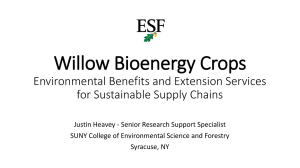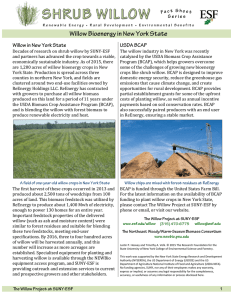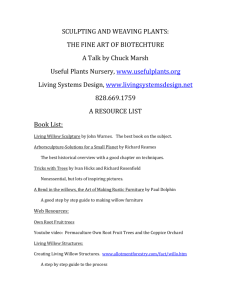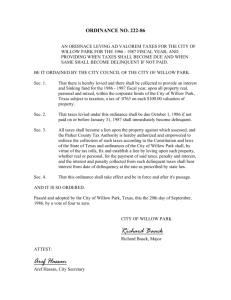Biomass and Bioenergy Justin Heavey
advertisement
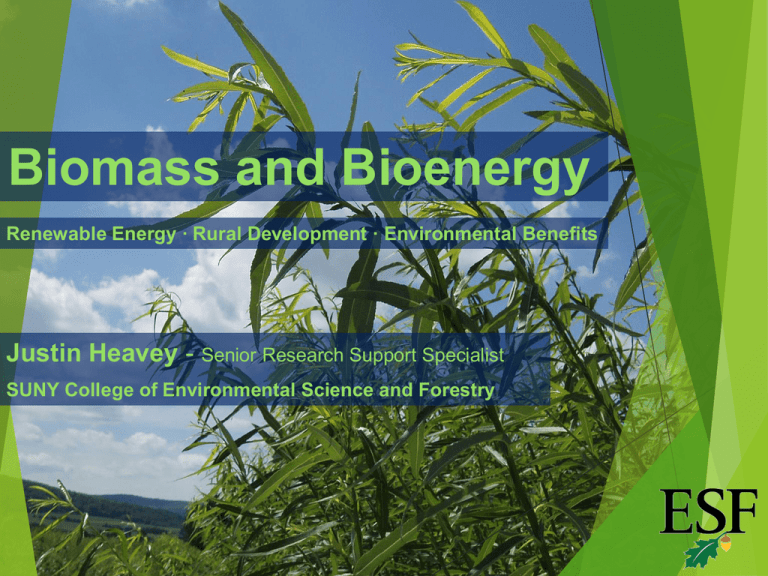
Biomass and Bioenergy Renewable Energy ∙ Rural Development ∙ Environmental Benefits Justin Heavey - Senior Research Support Specialist SUNY College of Environmental Science and Forestry My Background Education • B.S. Environmental Studies (Renewable Energy) • M.S. Natural Resources Management Experience • 2008-2011 Office of Sustainability at SUNY-ESF (Analyst) • 2011-2013 Research Foundation of SUNY (Research Assistant) • 2013-2015 Willow Project Research Group (Research Support Specialist) NEWBio Project (Extension Staff) Office of Sustainability at SUNY-ESF (Fellow) Instructor – Environmental and Energy Auditing Overview 1. Biomass & Bioenergy 2. The Willow Project at SUNY-ESF 3. Willow Production and Management 4. Environmental & Other Benefits Biomass and Bioenergy Bioenergy Energy from the sun stored in plants (biomass) • Agricultural Crops – Corn, soybeans, sunflower • Herbaceous Crops – Switchgrass, Miscanthus, ag residues • Woody Biomass – Fire wood, forest residues – Short rotation woody crops… • Poplar, southern pine, shrub willow (EIA, 2011) US Energy Use Renewable Energy= • 9% of total supply Biomass/Bioenergy = • • 43% of renewables Wood & Biofuels (EIA, 2011) Projected Biomass Supply • • • • Potentially large increase over next 15 years Largest percentage from energy crops i.e. Shrub willow and others 600 Million tons/year (dry) from energy crops alone (USDOE 2011) Policy Uncertainty CO2 reduction plans will be developed on a state by state basis. • 31% of U.S. CO2 emissions come from power plants • Federal Clean Power Plan (Aug. 2015) reduces CO2 power plant emissions by 32% (2005 base) by 2030 • May generate new interest in biomass, but the US EPA has not defined biomass or if it is C neutral, low C fuel or something else. Impact of Biomass Definitions • Amount of timberland that could be included as acceptable biomass is up to 70% lower in the EISA 2007 definition compared to the Farm Bill SUNY-ESF Willow Project Research on shrub willow since 1986 Breeding Yield trials Economic analysis Harvesting & Logistics Sustainability Multiple uses & benefits Commercialization of shrub willow for biomass energy and alternative applications Funding and Collaborators …and many others Willow Research Trials Willow Genus (Salix spp.) Shrub willow Not tree willows! Salix purpurea, Salix miyabeana, Salix sachlinensis, Salix viminalis, Salix eriocephala, Salix caprea... …and many cultivars of these species (Salix babylonica) Ecology of Shrub Willow • • Occurs naturally around rivers, wetlands and other fresh water ecosystems Wide geographic range including most of New York, US and Canada • Hundreds of species world wide - Salix spp. • Pioneer species adapted to wide range of conditions Regional History Onondaga County was the center of the U.S. willow basket industry in the early 1900s Hubbard, W. 1904. ESF initiated willow biomass research in 1986 Shrub Willow 5 dry tons/acre/year Adaptable to various sites Clonal Propagation Rapid Growth Rates Coppice Ability Limited pests & diseases Forestry •Woody plants •Hardwood biomass •Perennial species •Multi-year harvest cycle Agriculture Shrub Willow Bioenergy Crops •Agricultural lands •Agricultural machinery •Cultivation practices •Intensive crop management Three Years Growth Site Preparation Minor Maintenance Harvest Biomass 7 Crop Cycles Planting Seven Harvests Rapid Regrowth 15 dry tons/acre each harvest Coppice (cut-back) One Crop Establishment Mechanized Planting Unrooted Stem Cuttings Just Planted Double-Row Pattern 5,500 plants per acre 75% survival rate 2.5 foot Row spacing 6 foot Alley Spacing 2 foot Plant Spacing Few Weeks After Planting End of First Growing Season Coppice Mid-Summer Five to ten feet per year Five to Ten Feet per Year Large Woody Stems 1 to 2 inch diameter Mechanized Harvesting Cut Stools The Following Spring Repeat seven times Biomass Energy Feedstock Forest Residues/Slash • Logging byproduct • Harvest and thinning • Tree tops and branches • Non-Merchantable logs • Woody biomass feedstock Management Options Management Options Management Options Management Options Management Options Multiple Pathways Biopower Co-firing Thermal Combined Heat & Power Gasification Biorefinery Multiple Products State of the Willow Industry • 60 - 80 thousand acres in Europe (AEBIOM, 2011) - Development since 1970’s Higher fuel and biomass prices More renewable energy mandates and incentives • Commercial production in US - Less incentives, lower biomass prices Previous (unsuccessful) efforts Now 1200 acres established in northern NY Dedicated end user, 11 year contracts USDA BCAP SUNY-ESF, Cornell University, NEWBio Willow in Northern NY -About 1200 acres in the ground -Harvesting about 100 - 200 acres per year -Delivered to ReEnergy biopower facilities -Mixed with forest residues -Renewable electricity Jefferson Lewis Oneida Willow Production Area ReEnergy Biopower Facility Biomass Crop Assistance Program Catalyze commercial adoption & innovation… Partial establishment grants Land rental payments Purchasing contracts Lasting funding opportunity was 2013 Possible future funding Included in current farm bill Successful production and end use in Northern NY Project Sponsor – ReEnergy Holdings LLC ReEnergy Holdings • ~300 MWs of renewable energy generation • ~ 300 employees; 5 states Renewable Energy Facility Recycling Facility Headquartered in Latham, NY ReEnergy Holdings in New York • 80 employees • 103 MW of installed capacity, or 738,000 MWh – enough to serve 96,000 homes • $24 million in annual fuel purchases • Support more than 300 indirect jobs, most in the forest ReEnergy Facilities in NYS • ReEnergy Black River: 60 MW • ReEnergy Lyonsdale: 22 MW • ReEnergy Chateaugay: 21 MW ReEnergy Biopower • • • • Large demand for woody feedstocks Primarily forest residues Recent contract with Fort Drum Army Base 100% renewable electricity for next 20 years Fuel Supply Program • End-market for BCAP Shrub Willow • Equipment Leasing Program o ReEnergy launched a program allowing loggers to gain access to state-of-the-art equipment and secure long-term agreements to provide fuel to ReEnergy • SFI Certification o First company solely devoted to electricity production to be certified by SFI o Commitment to use best management practices and protect forest health Commercial Willow Feedstock • Over 5,900 tons of willow delivered to Lyonsdale and Black River facilities 2013-2015 • Willow found to be suitable fuel in terms of moisture and ash content, now incorporated directly with other feedstocks upon delivery. • Current willow plantings are planned to be harvested about 350-400 acres per year. • This will produce roughly 8,000-9,000 green tons of feedstock annually Willow Chip Quality Monitoring commercial willow chip quality since 2012… (Eisenbies et al. 2014, Conable et al. 2014, Heavey et al. 2015) Quality characteristics that meet or exceed end user specifications with low variability Suitable for mixing with forest residue chips for biopower Specifically…. Moisture: 43% ± 2% Ash: 3% ± 0.5% Energy: 8200-8300 btu/lb EcoWillow Model • • Cash flow model Willow biomass crops • User-friendly & customizable • Recently updated using.. • • All phases of production • • Commercial operations Latest research studies Example production scenarios Download at: www.esf.edu/willow Economics of Production Base Case Scenario 2014 • • • Conservative estimates of profitability 22-year life cycle of the planting including tear-out Does not include best BCAP incentives or best practice targets Model Outputs • • Break-even scenario Payback is entire life cycle of project Economics of Production Base Case Scenario + BCAP Incentives • 2014 base case assumptions and 2015 BCAP funding Model Outputs • • • • Positive NPV IRR 10% Payback… o 10 years after planting o Third Harvest All-in costs about $25/ton Economics of Production Improved Base Case + BCAP Incentives • Adds current BCAP incentives and best practice targets to base case Model Outputs • • • • Positive NPV IRR 20% Payback o 7 years after planting o Second harvest All-in costs about $20/ton Environmental Benefits …is renewable enough? Marginal and Idle Lands Can be grown on lower quality soils Idle land - Not profitable for ag in current markets 1 million acres in NYS - poorly drained, wet soils Tap underutilized resource Rural development Productive ecosystems Not compete with food/feed Carbon Neutral Lifecycle Net-zero GHG emissions (Caputo et al. 2014) Does not contribute to climate change CO2 sequestered above- and belowground Offsets +100% of emissions All phases of lifecycle • Power plant construction Energy Return on Investment It Takes Energy to Make Energy! Willow Energy Return • Between 15:1 and 45:1 (Caputo et al. 2014) Other Renewable Sources • Wind ~20:1 • Solar PV ~10:1 • Corn Ethanol ~2:1 or less Wildlife Willow increases habitat & biodiversity (Campbel et al. 2012) Birds and small mammals Bees and pollinators Beneficial soil organisms Deer, turkeys, other game Bioremediation Plants do work of machines & industrial processes…. Water filtration Soil remediation Landfill caps Pollution control Same traits as bioenergy.. High growth rate Coppice ability Fibrous root system Stress tolerances Numerous Benefits 1. Alternative landfill cap - cheaper and more effective 2. Produces bioenergy from willow stems 3. Protects local watershed and ecosystems 4. Documented increase in wildlife and biodiversity 5. Recreation opportunities - nature trails, bird watching, etc Willow systems can produce multiple-benefits… For comprehensive sustainability Other Environmental Benefits Low Impact… • Natural weed control (Heavey & Volk 2014) – limits the need for herbicides once crop is established • Disease and pest resistance (Abrahamson et al. 2010) – limits the need for pesticides • Low nutrient requirement, high nutrient cycling – – • limits need for fertilizers (energy/GHG/cost intensive) (Quaye et al. 2014, Hang et al. 2014) Perennial cover and root system (Kloster, 2014) – Limits soil erosion and nutrient loading dramatically compared to annual crops Jobs and Rural Development Previous estimates (NYSERDA 2010, Proakis et al. 1999)… 10,000 acres of bioenery crops… ~40 - 50 direct jobs ~20 - 30 indirect/induced jobs – Biomass production, transport and end-use Other Multifunctional Systems Living Snow Fences Stream Bank Stabilization Municipal/Organic Wastes Landscape/Ornamental Careers in Bioenergy • • • • • • • • • Researcher Educator Extension Producer End User Entrepreneur Manager Technician Policy Maker Summary Bioenergy is an important source of renewable energy Shrub willow is an ideal biomass feedstock Economics can be favorable More than just energy Rural development and careers Environmental benefits Thank You! Justin Heavey ESF Willow Project www.esf.edu/willow jpheavey@esf.edu


